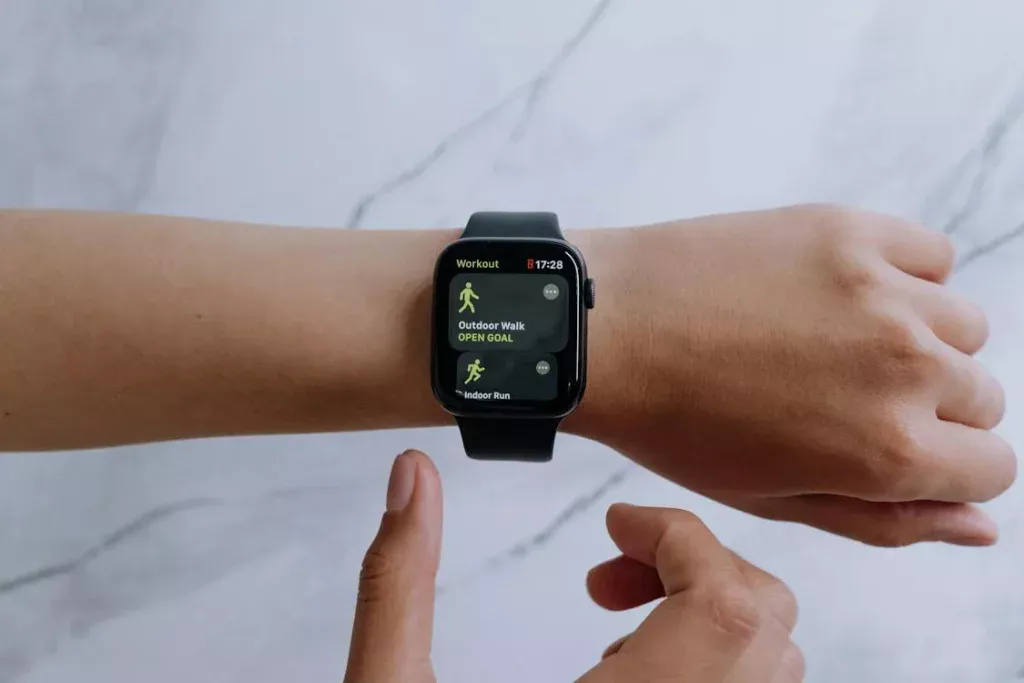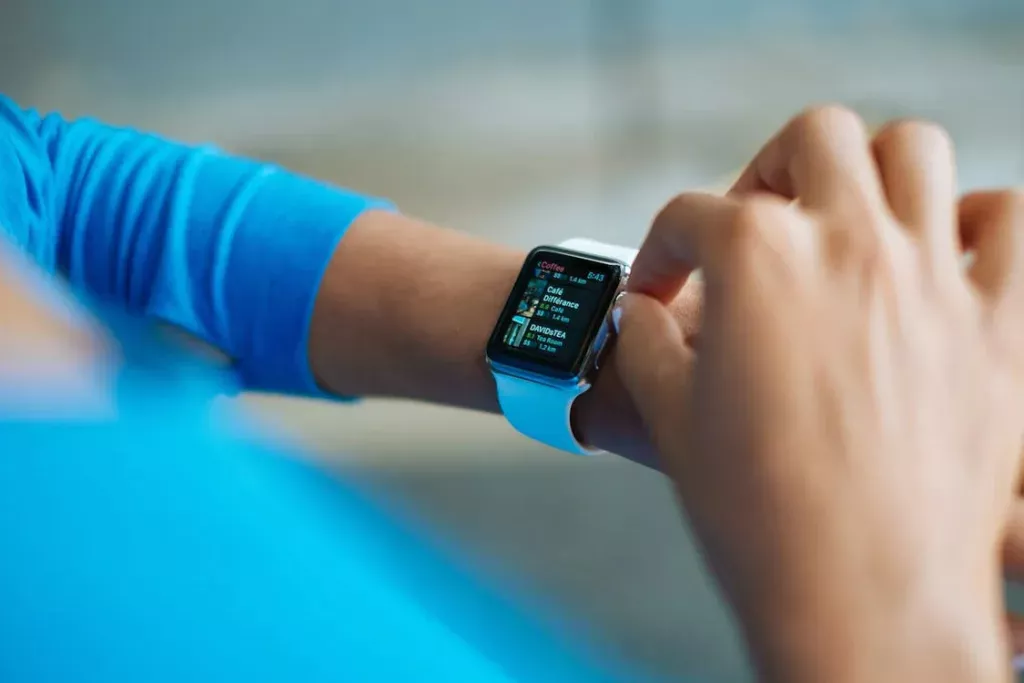Everyone knows that smartwatches are gaining popularity, so it’s no surprise to hear about new models being released on the market. As a design agency, we must look at these devices and evaluate whether the product is usable.
A smartwatch is a small, sometimes touchscreen-equipped wristwatch with added features compatible with a user’s smartphone. Unlike conventional wristwatches, a smartwatch usually comes with an operating system and can run Apps. UX design for smartwatches has advanced functionality like activity tracking and mobile payments. This blog post will outline the critical smartwatch design guidelines for user experiences.
Do Smartwatches Have UX Design?

The answer is yes. And why wouldn’t they? Smartwatches are a direct descendant of the first cell phones and tablets. They’re mini-computers that can do everything larger ones can, but in a smaller package. They’re also often worn on your wrist, which means they’re a part of your body; you can’t precisely ignore or forget about them.
So when you look at a smartwatch, what do you see? You see an interface designed to help you navigate menus and apps quickly, so you don’t have to pull out your phone constantly. You see animated emojis that make you smile when you get them in text messages from friends or family members. You see notifications coming in at all times of the day because they’re always there, so they never feel like intrusions on your privacy or mental space. And most importantly: you see technology that helps make life easier for everyone who owns one.
Read More: How to Become a UI/UX Designer?
Guidelines for Designing a Smartwatch
Smartwatches are a new category of devices that is quickly gaining popularity. They’re small, portable, and valuable for many different purposes, but UX design for smartwatches has some unique challenges.
Here are some guidelines for designing a smartwatch app or interface:
- Gestures
- Screen Specifications
- The Real-estate & Layout
- Limited actions on screen
- Margins & Paddings
- Haptics
- Typography
- Avoid complex functionalities or user flows
- Micro Interactions
- Alerts
- Recover from unintentional actions
- Buttons and Actions
- Inputs
- Colors
- Watch Faces
1) Gestures
Guiding users to the right experience is a significant challenge in the UX design for smartwatches. Users expect their watch to be as easy and intuitive as a smartphone or tablet. Still, they also have different needs and expectations when interacting with a smaller screen and limited battery life.
The key is to keep things simple and efficient. A good rule of thumb is that if you feel like you have to explain the interface to someone who has never used your smartwatch before, then it’s probably too complex.
2) Screen Specifications
The most crucial thing you must understand when designing a smartwatch is its screen specifications. The screen’s size and resolution will determine what kind of information you can display on it and how much space there is for user interface elements. If you’re designing for a round screen, make sure that all of your buttons and icons fit within the circle without any gaps between them, this will make them more accessible for users to press at any angle.
3) The Layout
The real estate and layout of your watch face are essential because it’s where your customers will spend most of their time using your product. This means you should think about how much information you want to display on the screen at any given time and how easy it will be for customers to read it there.
Make sure you have enough room on the screen for all the information you need to display at once, including text and images; otherwise, users may have trouble reading everything they need while using their watch.
4) Limited Screen Actions
Because of their small size and limited screen real estate, smartwatches have fewer buttons than most other devices. This means that you should limit the number of actions that can happen at any one time to make sure they’re easy to discover and understand.
5) Margins & Paddings

One great thing about designing a UX design for smartwatches is that they’re small. That means you have less screen space to work with, but just because the screen is small doesn’t mean you should ignore design principles like padding, margins, and alignment. These are still important for making your content look good on a smartwatch.
Start by setting your text size at 16px or 18px. This will keep things legible without sacrificing too much space.
Next, add some padding around your text, so it doesn’t get crowded on the screen; 1px of padding around each side is usually enough (but play around with it until you find what works best). You can also add a margin between paragraphs to visually separate them from one another. Again: test these things out until they feel suitable for your brand and audience!
6) Haptics (Vibration Feedback)
Haptic vibrations can be used in many ways but are usually used to alert users of an event or action. Vibrations can notify users of incoming messages, missed calls, calendar events, and alarms. Vibrations can also indicate that the user has reached the end of an article or that they have arrived at their destination. The vibration patterns will vary depending on what type of notification is received and where the user is located. For example, if a user receives a text message while driving, he will receive a different pattern than walking around town.
Vibrations are also helpful in alerting people when their activity levels fall below a certain threshold (e.g., if you haven’t moved in 10 minutes). Vibration patterns can help convey this information in a way that does not disturb other people nearby (e.g., instead of sounding an alarm).
7) Typography
Smartwatches are a fascinating and evolving product category. They’re not just a new way to interact with your phone; they’re also a platform that has opened up new design possibilities for interaction design, visual design, and UX design.
Typography should complement the text. Making writing intelligible, comprehensible, and clear is crucial. As UX designers, we’re tasked with ensuring that our users have the best possible experience when interacting with our products, and typography can help a lot.
8) Complex Functionalities Should Be Avoided
Since the first smartwatch launch, we’ve seen a flurry of new models. And while they all offer unique features and capabilities, one thing remains constant: most smartwatches are designed with functionality in mind. In other words, they do things and lots of them.
But what if you were to design a UX design for smartwatches that wasn’t just functional? What if your design focused on making it a delightful experience for the user? Focus on designing a smartwatch that will delight your users instead of just functioning as expected.
9) Micro Interactions
Smartwatches have tiny screens, so your user interface needs to be minimalistic and easy to navigate (even if it’s not touchscreen). Ensure no unnecessary animations or transitions, and keep buttons small enough to be easily pressed by one finger.
10) Alerts
The “alerts” feature in a smartwatch is becoming more popular because they make it easier for users to stay connected and informed about what’s going on in their lives. Smartwatches have been around for years, but they’re still evolving and only improving.
11) Recover From Unintentional Actions
When working on a UX design for smartwatches, you’ll want to consider how the device will be used in everyday life. Smartwatches are designed for quick actions, so you must ensure your users understand what action will do before taking it. If you can’t distinguish between actions clearly, users might take an unintended action and have to start over.
12) Accessibility of Features
The buttons and actions on the screen should easily accessible. Ensure the text on your app is large enough to read easily with one hand (so you don’t have to use two hands).
Design in accordance with UX principles like Fitts’ law (which states that the time required to move an object to its target is proportional to the distance moved) and Hick’s law (which states that reaction time increases as the number of choices increases).
13) Inputs
An essential step in creating UX design for smartwatches is understanding the inputs that will shape your design. These include:
- the screen size
- the number of buttons and what they do for users
- the type of input mechanism (touchscreen, buttons, etc.) and how it works with the other components on the watch body (e.g., a touchscreen while wearing gloves)
14) Colors
Colors should be bright and vibrant but not too distracting. The user should be able to glance at their wrist and know what the color means, but it should also work well with the rest of their outfit.
Colors are only part of a UX design for smartwatches; don’t rely on them alone to convey information.
15) Watch Faces
The watch face is the first thing you see when you look at your smartwatch. It’s the focal point of the device, and it should be designed to clarify what kind of information is being shown on the watch and how to use that information.
When designing a watch face, think about its primary function: To display time in an easy-to-read format. You can accomplish this through different design elements such as color or shape. The most important thing to remember is that you want your users to tell what time it is at a glance quickly.
Important Lessons to Learn Before Creating UX Design for Smartwatches

UX design for smartwatches is a very complex process. To create a fantastic experience for your users, you need to understand the fundamental principles that make a great product.
Here are some of the most important lessons to learn before working on UX design for smartwatches:
1) Be Direct
When it comes to UX design for smartwatches, focus on the user’s context and keep the interface simple and intuitive. Use visual cues rather than text, as these can help you be direct. Make sure there is enough space for all your content, and never stop thinking about making it easier for users to access information.
2) Glances & Notifications
Smartwatches have tiny screens that limit the amount of content you can display at once. To compensate, smartwatch designers often use glances and notifications to keep users informed about their watch’s status and activity.
3) Testing
One of the most important things to learn before creating a smartwatch UI design is how to test. Testing is essential to the success of any product, but it’s imperative in the case of smartwatches. If you don’t have time or money to devote to testing, you will likely end up with a clunky design that doesn’t accomplish what it needs.
Testing can be done in many ways:
- You can test yourself or others.
- You can use surveys.
- You can conduct usability tests where people try out prototypes and give feedback based on their experience using them.
- You could create a prototype and try it out yourself or get people who aren’t designers or developers involved in the process.
4) Increase Speed
The wearable revolution is upon us. Smartwatches, fitness trackers, and other wearable devices are becoming more popular daily. But while they have a lot of potentials, there’s still a lot of work to be done before they reach their full potential.
Some companies are already taking steps in the right direction by creating user experiences that are intuitive, simple, and speedy. But many others aren’t doing as much regarding the device’s speed.
5) Apps
Apps are a huge part of mobile device usage and are especially important on smartwatches. If you don’t have an app, you’re missing out on a huge opportunity to make money from your users. Plus, apps make it easy for users to access content and functionality from their wrists, which is one of the main reasons people love their smartwatches.
6) Complications
Creating an optimal UX design for smartwatches requires careful consideration of the device’s unique characteristics, limitations, and strengths. You can use Figma and InVision to help with the complications.
A smartwatch is a small screen with limited space and processing power. The smaller it is, the greater the complication. You need to figure out what you want your app to do before you start designing it. To do this, ask yourself: What problems does my app solve? What features does it have? Why does this feature exist? After answering these questions, you’ll be able to identify the best way to implement each feature in a way that makes sense for the platform.
7) Convenience
A significant factor in the success of any product is convenience; whether it’s a phone or a watch, people want things to be easy to use so they can get on with their lives. This means that an app should be designed with the user in mind first and foremost; if too many steps are involved or functions take forever to load up, people won’t use it.
8) Navigation and Responsiveness
If you’re working on UX design for smartwatches, you will have to learn how to make navigation and responsiveness work on a small screen.
If your navigation is difficult to understand or access, users will not be happy with their experience. Responsive web design allows for a seamless user experience across all platforms, but smartwatches are especially important because they are often used on mobile devices or other small screens.
9) No Unnecessary Animations
We’ve all had the experience of trying on a new watch that doesn’t feel right. Sometimes it’s because the buttons are too sensitive, and we’re accidentally scrolling through an entire month at a time. Sometimes it has unnecessary animations that aren’t convenient or simple to use.
In either case, we’re left frustrated and annoyed by our beautiful new timepiece.
This isn’t a problem that only affects watches; it can happen with any device or tool you use to interact with your world. The first step in creating a great user experience is recognizing what makes things feel good and what makes them feel bad.
Read More: How to Evaluate UX Design?
What You Need to Think About When Designing a Smartwatch UX

UX design for smartwatches is a tricky business, especially considering all the different ways people use this technology. But don’t worry! We’ve got your back! We’ve compiled all the key things you need to think about when designing a smartwatch UX so that you can confidently get started on your design project.
1) Think About How People Will Interact With Their Watch
Will they be using it at work? Or on the couch? Do they have kids who might be able to reach it? How often will they use it per day? These are all important questions you should answer before you start sketching your interface ideas.
2) Consider the User’s Needs
Consider the user’s needs and wants in terms of information and functionality. What does this person want from their watch? How does that differ from other people who might use it?
3) Make Sure That Your Design Is Easy-To-Use
Make sure your design is easy-to-use, intuitive, and aesthetically pleasing so that users won’t get frustrated trying to figure out how things work or what they’re supposed to do next while wearing it daily (or whenever).
Bottom Line
People won’t always have their smartphones with them when needed, but that doesn’t mean they will augment their smartphone screens with anything but. With further refinement and a price point commensurate to function, the smartwatch may become a necessary addition to one’s toolkit when traveling. One day soon, the smartphone and smartwatch may be essential devices in every traveler’s tech arsenal.
Overall, the smartwatch market is still finding its niche and has a long way to go before widespread adoption. However, we believe that 2024 will be the year wearable tech will move from being used mostly by fitness fanatics to more mainstream applications. For designers, this presents an incredible opportunity for innovation in a new field of devices with entirely new interaction models.
FAQs
What Kind of Technology Does a Smartwatch Use?
It might be compatible with Bluetooth, Wi-Fi, and GPS. For various uses, a “watch computer” acts as the user interface for a distant system, like a smartphone, and communicates with it via different wireless protocols.
What Tools Are Employed by UX Designers?
Photoshop, Illustrator, and Adobe XD are among Adobe’s Creative Cloud applications that are frequently regarded as industry standards. Numerous businesses and sectors utilize popular UX design platforms, including Figma and InVision.
